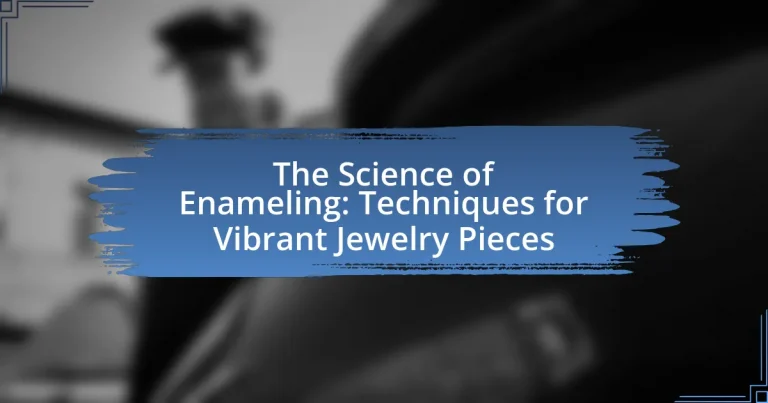The article focuses on the science of enameling, a process that fuses glass powder onto metal surfaces to create durable and colorful finishes in jewelry making. It explores the techniques involved, including cloisonné, champlevé, and basse-taille, and discusses the importance of temperature control, material selection, and firing methods in achieving successful enameling results. Additionally, the article highlights the aesthetic and durability benefits of enameling, common challenges faced during the process, and innovative trends shaping modern enameling practices. Practical tips for beginners are also provided to facilitate a better understanding of this intricate craft.

What is the Science of Enameling?
The science of enameling involves the fusion of glass powder onto a metal surface through heat, creating a durable and colorful finish. This process requires precise temperature control, typically between 1400°F to 1600°F, to ensure the glass adheres properly without damaging the underlying metal. The chemical composition of the enamel, including silica, flux, and colorants, plays a crucial role in achieving the desired aesthetic and functional properties. Studies have shown that the interaction between the enamel and metal can affect adhesion and durability, making the understanding of thermal expansion and contraction essential for successful enameling.
How does enameling work in jewelry making?
Enameling in jewelry making involves fusing powdered glass to metal surfaces through heat. The process begins by applying a layer of enamel powder onto a prepared metal substrate, typically copper, silver, or gold. Once the enamel is applied, the piece is heated in a kiln to temperatures ranging from 1400°F to 1600°F (760°C to 870°C), causing the glass particles to melt and bond with the metal. This fusion creates a durable, colorful coating that can be polished or layered for various effects. The technique has been used since ancient times, with historical evidence of enameling dating back to the Egyptians around 3000 BCE, demonstrating its long-standing significance in decorative arts.
What are the different types of enameling techniques?
The different types of enameling techniques include cloisonné, champlevé, basse-taille, and plique-à-jour. Cloisonné involves creating compartments with metal wires to hold enamel, while champlevé uses carved or etched areas in metal to contain the enamel. Basse-taille features a low-relief design that allows light to pass through the translucent enamel, and plique-à-jour is characterized by its openwork structure, resembling stained glass. Each technique has unique characteristics that contribute to the vibrancy and aesthetic appeal of jewelry pieces.
How does the choice of enamel affect the final piece?
The choice of enamel significantly impacts the final piece by influencing its color, durability, and overall aesthetic appeal. Different types of enamel, such as opaque, transparent, or opalescent, provide varying visual effects and depth, which can enhance the design of the jewelry. For instance, opaque enamel offers solid color coverage, while transparent enamel allows the underlying metal or design to show through, creating a layered effect. Additionally, the thermal properties of the enamel affect how well it adheres to the metal, impacting the piece’s longevity and resistance to wear. Research indicates that the composition of the enamel, including its glass content and additives, can alter its melting point and viscosity, further affecting the application process and final appearance.
Why is enameling important in jewelry design?
Enameling is important in jewelry design because it enhances aesthetic appeal and durability. The process involves fusing glass to metal, creating vibrant colors and intricate patterns that elevate the visual complexity of jewelry pieces. Additionally, enameling provides a protective layer that helps prevent tarnishing and wear, thus extending the lifespan of the jewelry. Historical evidence shows that enameling has been used since ancient times, with techniques such as cloisonné and champlevé being prominent in various cultures, demonstrating its long-standing significance in the art of jewelry making.
What aesthetic benefits does enameling provide?
Enameling provides vibrant color and a glossy finish, enhancing the visual appeal of jewelry pieces. The process allows for a wide range of hues and intricate designs, making each piece unique. Additionally, the smooth surface created by enameling reflects light beautifully, adding depth and dimension to the jewelry. This technique has been used historically, as seen in ancient artifacts, demonstrating its lasting aesthetic value in decorative arts.
How does enameling enhance the durability of jewelry?
Enameling enhances the durability of jewelry by creating a protective layer that is resistant to scratches, tarnishing, and corrosion. This glass-like coating bonds to the metal surface, providing a barrier that shields the underlying material from environmental factors such as moisture and air, which can lead to deterioration. Additionally, enameling can improve the overall structural integrity of the jewelry piece, as the fused glass adds strength and stability. Studies have shown that properly applied enamel can significantly extend the lifespan of jewelry, making it more resilient to everyday wear and tear.

What are the key techniques used in enameling?
The key techniques used in enameling include cloisonné, champlevé, and basse-taille. Cloisonné involves creating compartments with metal wires to hold different colors of enamel, allowing for intricate designs. Champlevé requires carving or etching the metal surface to create recesses that are filled with enamel, resulting in a textured appearance. Basse-taille utilizes a technique where the metal surface is engraved or patterned before applying a transparent enamel, enhancing the depth and richness of the color. These techniques are foundational in producing vibrant and detailed enamel jewelry pieces.
How do different firing methods impact enameling?
Different firing methods significantly impact the quality and characteristics of enameling. For instance, kiln firing allows for controlled temperatures and even heat distribution, resulting in a smooth, durable finish, while torch firing can create more varied textures and colors due to its localized heat application. Research indicates that kiln firing typically achieves better adhesion and fewer defects compared to torch firing, which may lead to uneven results. The choice of firing method directly influences the final appearance, durability, and overall success of the enameling process.
What are the differences between kiln firing and torch firing?
Kiln firing and torch firing are two distinct methods used in enameling. Kiln firing involves placing pieces in a controlled environment where heat is evenly distributed, allowing for consistent melting and adherence of enamel to metal. This method typically reaches higher temperatures, around 1400°F to 1600°F, and is suitable for larger pieces or multiple items at once. In contrast, torch firing utilizes a handheld torch to apply direct heat to the enamel, allowing for more immediate and localized melting. This method is generally used for smaller pieces and requires careful control to avoid overheating or uneven results. The differences in temperature control, scale of application, and heating methods define the unique characteristics and suitability of each technique in the enameling process.
How does temperature control affect the enameling process?
Temperature control is crucial in the enameling process as it directly influences the fusion of enamel to the substrate. Proper temperature ensures that the enamel melts uniformly, creating a strong bond and preventing defects such as bubbling or cracking. For instance, enameling typically requires temperatures between 1400°F to 1600°F; exceeding these temperatures can lead to over-firing, which compromises the integrity of the enamel. Conversely, insufficient heat can result in incomplete melting, leading to poor adhesion and a dull finish. Therefore, precise temperature management is essential for achieving vibrant and durable enamel finishes in jewelry making.
What tools and materials are essential for enameling?
Essential tools and materials for enameling include a kiln, enamel powders, metal substrates, a sifter, brushes, and safety equipment. The kiln is crucial for firing the enamel, which requires high temperatures to fuse the glass particles to the metal. Enamel powders come in various colors and types, allowing for creative expression in jewelry design. Metal substrates, such as copper or silver, serve as the base for the enamel application. A sifter is used to evenly distribute the enamel powder, while brushes help in applying the enamel precisely. Safety equipment, including gloves and goggles, is necessary to protect against harmful fumes and hot materials during the enameling process.
What types of enamel are available for jewelry making?
The types of enamel available for jewelry making include opaque enamel, transparent enamel, opalescent enamel, and cloisonné enamel. Opaque enamel provides solid color coverage, while transparent enamel allows the underlying metal or design to show through, enhancing visual depth. Opalescent enamel features a shimmering effect, and cloisonné enamel involves using metal wires to create compartments filled with colored enamel, resulting in intricate designs. Each type serves distinct artistic purposes and techniques in the enameling process.
Which tools are necessary for successful enameling?
Successful enameling requires a set of essential tools, including a kiln, enamel powders, a sifter, a brush, tweezers, and a firing rack. The kiln is crucial for reaching the high temperatures needed to fuse the enamel to the metal. Enamel powders come in various colors and are the primary material used in the enameling process. A sifter ensures even application of the enamel, while a brush helps in precise placement. Tweezers are necessary for handling small pieces safely, and a firing rack allows for proper airflow during the firing process. Each of these tools plays a vital role in achieving vibrant and durable enamel finishes on jewelry pieces.

What are common challenges in the enameling process?
Common challenges in the enameling process include achieving proper adhesion, controlling the firing temperature, and preventing defects such as bubbles or cracks. Proper adhesion is critical, as inadequate bonding between the enamel and substrate can lead to chipping or peeling. Controlling the firing temperature is essential because overheating can cause the enamel to burn or discolor, while underheating may result in incomplete melting. Additionally, defects like bubbles can occur due to trapped air or moisture, and cracks may arise from thermal shock during cooling. These challenges require careful monitoring and technique to ensure a successful enameling outcome.
How can one troubleshoot common enameling issues?
To troubleshoot common enameling issues, one should first identify the specific problem, such as bubbling, cracking, or discoloration. For bubbling, ensure that the enamel is applied in thin layers and that the piece is preheated to reduce moisture. Cracking can be mitigated by controlling the cooling rate after firing, as rapid temperature changes can cause stress. Discoloration often results from impurities in the enamel or metal; using high-quality materials and ensuring proper cleaning of the surface before application can prevent this. These troubleshooting methods are supported by the principles of thermal expansion and material compatibility in enameling, which emphasize the importance of proper technique and material selection.
What are the causes of bubbling in enamel?
Bubbling in enamel is primarily caused by the presence of moisture or contaminants on the surface before firing. When enamel is applied to a substrate, any trapped moisture or oils can vaporize during the heating process, leading to the formation of bubbles. Additionally, improper firing temperatures can exacerbate this issue, as too high a temperature can cause the enamel to expand rapidly, resulting in bubbling. Studies in materials science indicate that maintaining a clean surface and controlling firing conditions are critical to preventing these defects in enamel work.
How can one prevent cracking in enamel pieces?
To prevent cracking in enamel pieces, one should ensure proper temperature control during the firing process. Maintaining a consistent temperature helps avoid thermal shock, which is a primary cause of cracking. Additionally, using high-quality enamel and applying it in thin layers can reduce stress on the piece as it cools. Research indicates that enamel compositions with lower coefficients of thermal expansion are less prone to cracking, supporting the importance of material selection in the enameling process.
What best practices should be followed for successful enameling?
Successful enameling requires meticulous preparation, precise application, and controlled firing. First, ensure the metal surface is clean and free from oxidation, as contaminants can prevent proper adhesion of the enamel. Next, apply a thin, even layer of enamel powder, using a sifting technique to achieve uniform coverage. It is crucial to fire the piece at the correct temperature, typically between 1400°F to 1600°F, for the appropriate duration to ensure proper melting and bonding of the enamel to the metal. Additionally, allow the piece to cool gradually to avoid thermal shock, which can cause cracking. Following these practices enhances the durability and vibrancy of the enamel finish, as supported by industry standards in jewelry making.
How can one ensure proper adhesion of enamel to metal?
To ensure proper adhesion of enamel to metal, one must thoroughly clean and prepare the metal surface before applying enamel. This involves removing any oxidation, grease, or contaminants through methods such as sandblasting or using a chemical cleaner. Studies indicate that a roughened surface enhances mechanical bonding, which is critical for adhesion. Additionally, applying a suitable primer or base coat can further improve the bond between the enamel and the metal.
What tips can enhance the vibrancy of enamel colors?
To enhance the vibrancy of enamel colors, use high-quality pigments and ensure proper firing temperatures. High-quality pigments provide richer hues and better lightfastness, while precise firing temperatures prevent color distortion and promote optimal adhesion to the metal surface. Research indicates that maintaining a consistent temperature during the enameling process can significantly affect the final color outcome, as variations can lead to dull or uneven finishes. Additionally, applying multiple thin layers of enamel rather than a single thick layer can also enhance vibrancy, as this technique allows for better color saturation and depth.
What are some innovative trends in enameling for jewelry?
Innovative trends in enameling for jewelry include the use of new materials, such as synthetic enamels that offer greater durability and a wider color palette. Additionally, techniques like cloisonné and champlevé are being reimagined with modern technology, allowing for more intricate designs and precision. The incorporation of mixed media, combining enameling with other materials like resin or metal, is also gaining popularity, enabling unique textures and finishes. Furthermore, eco-friendly enameling processes are emerging, utilizing sustainable practices and materials to reduce environmental impact. These trends reflect a shift towards creativity and sustainability in the jewelry industry.
How is technology influencing modern enameling techniques?
Technology is significantly influencing modern enameling techniques by introducing advanced materials and precision tools that enhance the quality and efficiency of the enameling process. For instance, the use of digital kilns allows for precise temperature control, which is crucial for achieving consistent results in enamel application. Additionally, innovations such as laser technology enable artists to create intricate designs with high accuracy, reducing the risk of errors that can occur with traditional methods. Furthermore, the development of new enamel formulations, including lead-free options, has improved safety and environmental impact while maintaining vibrant color and durability. These advancements demonstrate how technology is reshaping the enameling landscape, making it more accessible and versatile for contemporary artisans.
What new materials are being explored in enameling?
New materials being explored in enameling include innovative glass formulations, metal oxides, and eco-friendly alternatives like recycled glass. Researchers are focusing on developing glass compositions that enhance color vibrancy and durability, while metal oxides are being utilized to create unique color effects and textures. Additionally, the use of recycled glass not only promotes sustainability but also offers a diverse palette for artists. These advancements are supported by studies highlighting the improved performance and aesthetic qualities of these materials in contemporary enameling practices.
What are practical tips for beginners in enameling?
Practical tips for beginners in enameling include starting with a clean metal surface, using high-quality enamel powders, and applying thin layers of enamel to avoid bubbling. Clean surfaces ensure proper adhesion, while quality materials enhance color vibrancy and durability. Thin layers allow for even heating and reduce the risk of defects, as thicker applications can lead to issues during firing. Additionally, beginners should familiarize themselves with the firing schedule specific to their enamel type, as different enamels require varying temperatures and times for optimal results.


